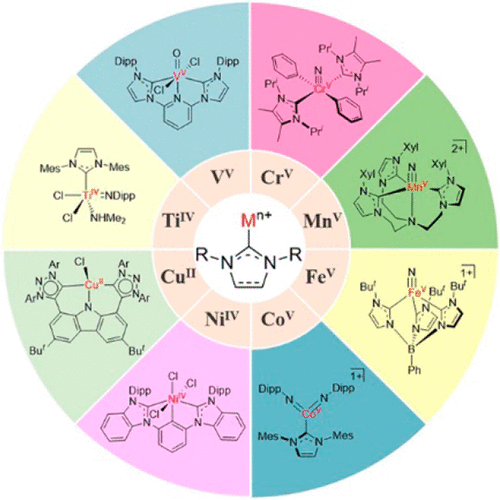当前位置:
X-MOL 学术
›
Chem. Rev.
›
论文详情
Our official English website, www.x-mol.net, welcomes your feedback! (Note: you will need to create a separate account there.)
High-Oxidation-State 3d Metal (Ti–Cu) Complexes with N-Heterocyclic Carbene Ligation
Chemical Reviews ( IF 62.1 ) Pub Date : 2018-07-16 00:00:00 , DOI: 10.1021/acs.chemrev.8b00096 Jun Cheng 1 , Lijun Wang 1 , Peng Wang 1 , Liang Deng 1
Chemical Reviews ( IF 62.1 ) Pub Date : 2018-07-16 00:00:00 , DOI: 10.1021/acs.chemrev.8b00096 Jun Cheng 1 , Lijun Wang 1 , Peng Wang 1 , Liang Deng 1
Affiliation

|
High-oxidation-state 3d metal species have found a wide range of applications in modern synthetic chemistry and materials science. They are also implicated as key reactive species in biological reactions. These applications have thus prompted explorations of their formation, structure, and properties. While the traditional wisdom regarding these species was gained mainly from complexes supported by nitrogen- and oxygen-donor ligands, recent studies with N-heterocyclic carbenes (NHCs), which are widely used for the preparation of low-oxidation-state transition metal complexes in organometallic chemistry, have led to the preparation of a large variety of isolable high-oxidation-state 3d metal complexes with NHC ligation. Since the first report in this area in the 1990s, isolable complexes of this type have been reported for titanium(IV), vanadium(IV,V), chromium(IV,V), manganese(IV,V), iron(III,IV,V), cobalt(III,IV,V), nickel(IV), and copper(II). With the aim of providing an overview of this intriguing field, this Review summarizes our current understanding of the synthetic methods, structure and spectroscopic features, reactivity, and catalytic applications of high-oxidation-state 3d metal NHC complexes of titanium to copper. In addition to this progress, factors affecting the stability and reactivity of high-oxidation-state 3d metal NHC species are also presented, as well as perspectives on future efforts.
中文翻译:

N杂环碳链连接的高氧化态3d金属(Ti-Cu)配合物
高氧化态的3d金属物种在现代合成化学和材料科学中发现了广泛的应用。它们也被认为是生物反应中的关键反应物种。因此,这些应用促使人们对其形成,结构和性质进行探索。尽管有关这些物种的传统知识主要来自氮和氧供体配体支持的配合物,但最近对N的研究杂环卡宾(NHC)广泛用于有机金属化学中的低氧化态过渡金属配合物的制备,已导致制备了多种具有NHC连接的可分离的高氧化态3d金属配合物。自1990年代该领域首次报道以来,已经报道了这种类型的可分离络合物,包括钛(IV),钒(IV,V),铬(IV,V),锰(IV,V),铁(III), IV,V),钴(III,IV,V),镍(IV)和铜(II)。为了概述这一有趣的领域,本综述总结了我们目前对钛到铜的高氧化态3d金属NHC金属配合物的合成方法,结构和光谱特征,反应性和催化应用的理解。除了这方面的进步外,
更新日期:2018-07-16
中文翻译:

N杂环碳链连接的高氧化态3d金属(Ti-Cu)配合物
高氧化态的3d金属物种在现代合成化学和材料科学中发现了广泛的应用。它们也被认为是生物反应中的关键反应物种。因此,这些应用促使人们对其形成,结构和性质进行探索。尽管有关这些物种的传统知识主要来自氮和氧供体配体支持的配合物,但最近对N的研究杂环卡宾(NHC)广泛用于有机金属化学中的低氧化态过渡金属配合物的制备,已导致制备了多种具有NHC连接的可分离的高氧化态3d金属配合物。自1990年代该领域首次报道以来,已经报道了这种类型的可分离络合物,包括钛(IV),钒(IV,V),铬(IV,V),锰(IV,V),铁(III), IV,V),钴(III,IV,V),镍(IV)和铜(II)。为了概述这一有趣的领域,本综述总结了我们目前对钛到铜的高氧化态3d金属NHC金属配合物的合成方法,结构和光谱特征,反应性和催化应用的理解。除了这方面的进步外,


























 京公网安备 11010802027423号
京公网安备 11010802027423号